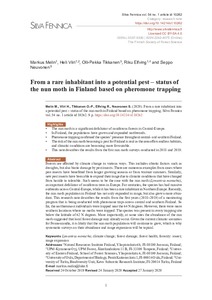From a rare inhabitant into a potential pest - status of the nun moth in Finland based on pheromone trapping
Neuvonen S; Elfving R; Tikkanen OP; Viiri H; Melin M
From a rare inhabitant into a potential pest - status of the nun moth in Finland based on pheromone trapping
Neuvonen S
Elfving R
Tikkanen OP
Viiri H
Melin M
FINNISH SOC FOREST SCIENCE-NATURAL RESOURCES INST FINLAND
Julkaisun pysyvä osoite on:
https://urn.fi/URN:NBN:fi-fe2021042823078
https://urn.fi/URN:NBN:fi-fe2021042823078
Tiivistelmä
Forests are affected by climate change in various ways. This includes abiotic factors such as droughts, but also biotic damage by pest insects. There are numerous examples from cases where pest insects have benefitted from longer growing seasons or from warmer summers. Similarly, new pest insects have been able to expand their range due to climatic conditions that have changed from hostile to tolerable. Such seems to be the case with the nun moth (Lymantria monacha), an important defoliator of coniferous trees in Europe. For centuries, the species has had massive outbreaks across Central-Europe, while it has been a rare inhabitant in Northern Europe. Recently, the nun moth population in Finland has not only expanded in range, but also grown more abundant. This research note describes the results from the first years (2018-2019) of a monitoring program that is being conducted with pheromone traps across central and southern Finland. So far, the northernmost individuals were trapped near the 64 N degrees. However, there were more southern locations where no moths were trapped. The species was present in every trapping site below the latitude of 62 N degrees. More importantly, at some sites the abundance of the nun moth suggested that local forest damage may already occur. Given the current climatic scenarios for Fennoscandia, it is likely that the nun moth populations will continue to grow. which is why systematic surveys on their abundance and range expansions will be topical.
Kokoelmat
- Rinnakkaistallenteet [19249]
